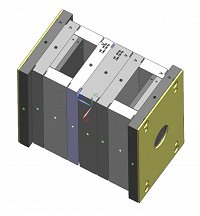Faster design of injection moulds using parametric data from HASCO
05.02.2020
As a leading supplier of standardised components for tool and mouldmaking, HASCO sets out to provide designers with the best possible support. Close cooperation with designers and reliable software partners allows user-friendly implementation of the required standard components for the construction of injection moulds.
 HASCO supplies a range of attractive tools for optimising the design of injection moulds and the internationally operating standard-component specialist is increasingly supporting the design process through the provision of native data. These native databases, for Siemens NX, Catia and Cimatron in the first instance, are designed for those using the respective CAD software and are available directly in the system. The parametric structure of all the standard components is maintained by HASCO and competent CAD partners to ensure it is always up to date.
HASCO supplies a range of attractive tools for optimising the design of injection moulds and the internationally operating standard-component specialist is increasingly supporting the design process through the provision of native data. These native databases, for Siemens NX, Catia and Cimatron in the first instance, are designed for those using the respective CAD software and are available directly in the system. The parametric structure of all the standard components is maintained by HASCO and competent CAD partners to ensure it is always up to date.
The key advantage of native data compared with STEP files, or other exchange formats, is that it can be easily modified, which also makes it much easier to handle the data of the required components in parts lists. HASCO was prompted to offer this data through the close cooperation it has enjoyed with the Radtke design office in Espelkamp/Germany. Over the past few years, this latter company has been working intensively on the use of native data and has shown how users can benefit from the options and advantages it opens up.
Horst Radtke, founder and owner of the Radtke design office in Espelkamp, had already decided, towards the end of his toolmaker training, that he would like to become a tool designer and set up his own business at some stage. In 1988, he started work in the design department of a well-known automotive supplier company in the area.
After founding his own business on the side in 1993, he finally switched to full self-employment in 1997. And, for Horst Radtke, this was also the time he made the move into 3D-CAD design. Today, the company employs four designers and one technical drawer for the design of injection moulds. Since 2016, the company has been consistently pursuing the rejuvenation process required for the future. With the entry of the founder’s son, Florian Radtke, into the company four years ago, the future of the company has been secured.
A further key focus of the work carried out at the design office is on complex plug moulds, especially for the automotive industry and white goods. Nested moulds with up to 64 cavities are designed here. They are capable of processing TPE and LSR silicones, as well as PA66GF30, PC, PBT and other engineering plastics. In addition, Radtke and his team also design moulds for medical technology and other sectors, including the consumer goods and packaging industries.
To be able to design moulds of this type in as effective and time-saving manner as possible, the desire arose for the provision of native, parameterised data rather than the STEP data supplied by the standard-component manufacturers.
“When I download design data from the standard-component manufacturers from the internet”, I have so far generally been working with STEP data”, Horst Radtke explains. But STEP data is dead data, compared with a screenshot.
Against this background, the Radtke design office began, a few years ago, to develop its own database of parametrised data for standard components. In the initial stage, HASCO provided Excel lists with the necessary parameters. “We have enjoyed a close working relationship with HASCO based on trust right from the start”, says Horst Radtke.
The actual design is, naturally, only one part of the entire process. Parts lists and order lists also have to be generated. This metadata runs in the background and is also now automatically updated – something that is not possible when using STEP data.
As a rule, this data is loaded directly into the customer’s CAD system via an exchange format. During the transfer, however, parameters and information for individual products can get lost.
Imagine it like this: You are French and are talking to an Italian in English. You understand each other but, despite your knowledge of English, some information gets lost in the conversation. This would be the case if exchange formats like STEP were used. By employing native data, by contrast, all the parameters and information on the product are retained and can be seamlessly processed. “We speak one and the same language – it couldn’t be easier or safer”, emphasizes Daniel Dirksen, Technical Marketing HASCO.
The creation of a parametric component database was only the first step, because the parametric data can naturally be used intelligently in a large number of other ways.
Radtke has also designed a large number of component assemblies and saved them in parametric form, including a “starting assembly” with a variable configuration of ejector systems, plate numbers and tandem and stack technologies. Everything is parametric, with the corresponding metadata for compiling the parts list, which is updated in the background. Only the material grades and hardnesses have to be entered manually. All the other data is provided by the CAD system and read out into customer-specific templates and exported. Therefore, compilation of the mould base and the associated parts list requires considerably less effort.





































